How to hide heating pipes: analysis of the 3 most popular ways
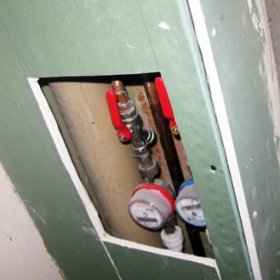
The appearance of the premises concerns residents no less than their functionality. Therefore, it is unlikely that anyone will like heating pipes put up for display. Apartments with such highways look quite unpresentable. Knowing how to decorate a heating pipe, you can not only hide unsightly elements, but also create an interesting decor of the room.
Of the possible options for masking the heating main, three can be distinguished:
- hiding pipes in the floor or walls;
- masking pipes with a box;
- decoration of heating elements.
Let's go through each of the options in more detail.
Content
Option # 1 - masking pipes inside walls or floors
Before considering how to hide pipes heating inside any of the surfaces, you need to know which pipes can be bricked into the floor or wall. In no case can you hide the old highway. It is better to replace them with new ones before that. Depending on which pipes will be used for heating, the method of their installation is selected.
In polypropylene products, linear expansion reaches 5 mm, so during the installation process it is necessary to provide the necessary number of expansion joints. Before wiring in the wall, special plastic casings are put on metal-plastic pipes to reduce heat loss. In addition, irrespective of the type of products used for laying the heating line, it is not allowed to brick the detachable fittings.
Before masking the heating pipes, it is necessary to draw up a circuit for laying the mains. Based on it, they make special recesses in those places where the pipes will be walled up. The size of the plug is calculated taking into account the thickness of the mortar and the insulating material. For reliable fastening of the trunk in the wall, holes are made into which dowels and brackets are inserted. Having prepared the holders, put on a casing on the pipes and lay it in the wall.
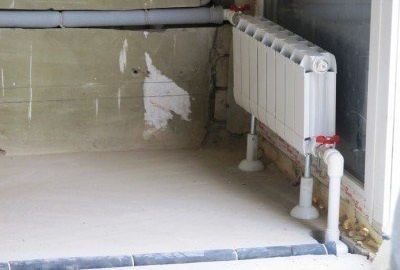
Before you start laying heating pipes in a wall or floor, you must put on a special casing on them. It will help eliminate heat loss.
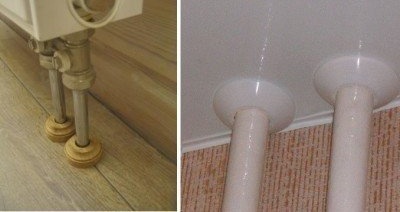
In the process of wiring pipes into the floor, it is not always possible to design a hole beautifully. For these purposes, you can use a decorative overlay, which can be matched to the tone of the floor covering.
Just starting to design wiring in an apartment or house? Then pay attention to the material, which describes the common mistakes made during installation:https://aquatech.tomathouse.com/en/santehnika/razvodka/pravilnaya-razvodka-trub-v-vannoj-i-tualete.html. This will help you get the system right.
Having connected the system, it is tested and only after that the strobes are closed with a solution. In this way, the trunk is hidden on the floor. In order to beautifully mask the places where pipes enter the floor, decorative overlays for heating pipes are used.At the end of the installation process, an executive circuit is drawn up. It marks the passage of the highway. This is necessary so that during the repair work not to violate the integrity of the hidden pipeline.
Option # 2 - box on the frame for the heating main
If you have already laid the heating system, and now you want to hide it, you can hide the pipes in the box. It is made of plastic, drywall or wooden materials, which are mounted on a frame. Before sewing pipes into a box, make sure they are intact!
To install the box you will need:
- metallic profile;
- screws with dowels;
- sheathing material;
- screwdriver;
- cutter;
- knife for cutting sheathing material;
- drill;
- scissors for cutting a profile;
- measuring tools.
The first step is to build a frame for the box. It is made of a metal profile or wooden bars, which are fixed with self-tapping screws. First, markings are made around the pipes, depending on their location on the floor, walls and ceiling. In this case, you must take into account the width of the profile or bars, the size of the finishing material and the distance from the pipes to the walls of the box.
Heating pipes should not be located close to the duct. Between them leave free space at least 3 cm wide.
In the case of closing the risers located in the corner of the room it happens that the walls are not even. In this case, it is more expedient to make the angles formed by the walls and the duct 90 °, and equalize the protruding angle. After marking, proceed to the installation of rack profiles to the walls. Then fasten guides on a floor and a ceiling. Between themselves, the profile is fastened with a notch.
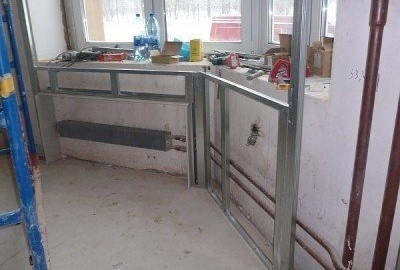
The height of the corner frame for vertical pipes is more than 1.5 m. Therefore, for its strength, horizontal jumpers must be fixed. If the distance between the racks is more than 0.25 m, they must also be strengthened.
Further, depending on the design of the future box, one or two corner profiles are mounted. If the distance between the racks is more than 0.25 m, additional jumpers must be made parallel to them. If the racks are above one and a half meters, you must install horizontal jumpers. After the construction of the frame proceed to its lining. If drywall is used for this purpose, then before closing the heating pipes with it, it is necessary to remove the bevels from the sheets. This process is skipped if the box is subsequently tiled.

After all the elements of the frame are installed, they proceed to the cutting of the sheathing material. This should be done so that there are fewer joints
Initially fix the side elements, and then the central ones. After completion of installation work, they proceed to the final finishing of the box. The structure of drywall can be glued with wallpaper or painted to match the walls. Special corners are placed on the plastic elements so that the joints are not visible. Drywall reinforced with an angular profile. It looks very interesting box, the front of which is a stained glass window. You can enhance the effect by constructing a backlight inside.
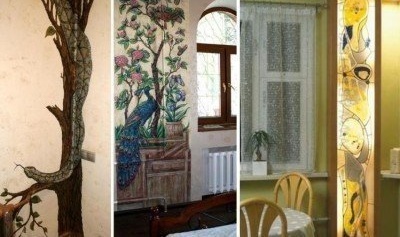
Masking heating pipes can be turned into a real work of art, a decorative stained-glass window with interior lighting looks interesting
Some structural elements can be made removable or small doors can be hung for system maintenance.
In rooms where heating elements occupy a large area of the wall, it is possible to build a false wall. They make it by the same method as the box. First, the frame is mounted, and then sheathed with a suitable material. However, note that false wall reduces the area of the room. Also, to hide the heating pipes, a ready-made box is used. On sale you can choose the right option for any room design.
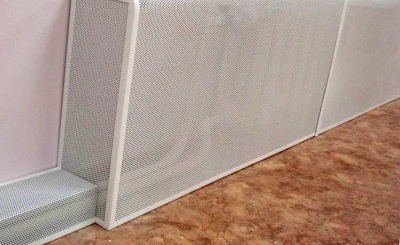
To mask the heating elements, you can purchase a finished box made of perforated metal. Thanks to small openings, heat penetrates into the room
You will find step-by-step installation instructions for the pipe duct in our following material:https://aquatech.tomathouse.com/en/uchebnik/montazh/korob-dlya-trub-v-vannoj.html.
Option # 3 - we don’t hide the pipes, but decorate
Closing the heating pipes in the box, as well as blocking it into the walls or floor, reduces their heat transfer. In some cases, this is simply undesirable. If you cannot or do not want to close the heating pipes, think about how to mask unsightly elements with the help of decoration. This method makes it possible to express your imagination. The main condition is that the decor matches the style of the room in which it is used. Metal heating elements can simply be painted to match the walls next to which they are located. The following requirements are applied to the paints used:
- resistance to mechanical stress;
- heat resistance;
- non toxicity.
Proceeding from this, water-dispersion paints, acrylic and alkyd enamels are used for coloring metal heating elements.
You can decorate the heating pipes by wrapping them with a jute or hemp rope. However, note that this also reduces the heat transfer of the system. You can use another rather interesting option - fastened split along the bamboo to the pipe. In addition, castings, flowers or other decoration elements are hung on the heating elements. It all depends on the imagination of the decorator. Pipes horizontally located under the ceiling can be easily closed by hanging curtains or curtains on them.

By wrapping a horizontal pipe in a rope, you will not only hide it, but also create a decorative element to decorate the room. A few green twigs will revive her
It is easier to close the pipes with a box or decor than, for example, a large boiler. But this is fixable. Read about options in our next article:https://aquatech.tomathouse.com/en/otoplenie/kotly/dizajnerskie-nyuansy-oformleniya-gazovogo-kotla-na-kuxne.html.
Much better for those who are just going to conduct a heating main in a house or apartment. It is possible to arrange the pipes so that they are less noticeable. In this case, you don’t have to think about disguising them. This fate also bypasses those who choose a warm floor for space heating.

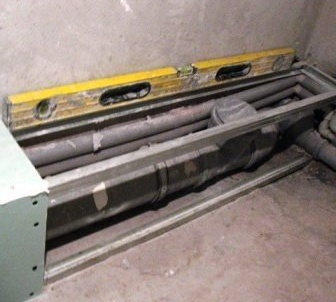

2 comments